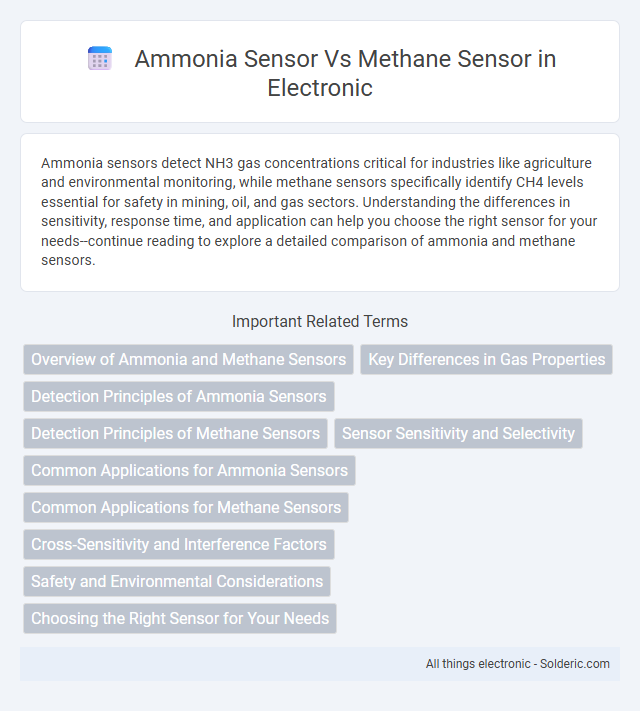Ammonia sensors detect NH3 gas concentrations critical for industries like agriculture and environmental monitoring, while methane sensors specifically identify CH4 levels essential for safety in mining, oil, and gas sectors. Understanding the differences in sensitivity, response time, and application can help you choose the right sensor for your needs--continue reading to explore a detailed comparison of ammonia and methane sensors.
Comparison Table
| Feature | Ammonia Sensor | Methane Sensor |
|---|---|---|
| Detection Gas | Ammonia (NH3) | Methane (CH4) |
| Detection Range | 0-100 ppm (varies by model) | 0-100% LEL (Lower Explosive Limit) |
| Application | Industrial safety, agriculture, refrigeration | Mining, environmental monitoring, leak detection |
| Sensor Type | Electrochemical, metal-oxide, photoacoustic | Infrared, catalytic bead, metal-oxide |
| Response Time | 5-30 seconds | 2-20 seconds |
| Sensitivity | High sensitivity to ppm levels | High sensitivity to flammable gas concentrations |
| Interference | May cross-react with amines, humidity-sensitive | Can be affected by propane, hydrogen, humidity |
| Power Consumption | Low to moderate | Moderate to high (especially IR sensors) |
| Cost | Moderate | Moderate to high |
Overview of Ammonia and Methane Sensors
Ammonia sensors detect NH3 gas levels, commonly used in agriculture, refrigeration, and industrial safety to monitor toxic and corrosive environments. Methane sensors measure CH4 concentrations, critical for detecting combustible gas leaks in mining, oil, and natural gas industries to prevent explosions. Your choice depends on the specific gas detection needs, with ammonia sensors focusing on irritant gases and methane sensors targeting flammable gas detection.
Key Differences in Gas Properties
Ammonia sensors detect NH3, a pungent, corrosive gas with high solubility in water, while methane sensors target CH4, a colorless, odorless, and highly flammable hydrocarbon. Ammonia's polar nature and strong affinity for moisture influence sensor selectivity and require robust materials resistant to corrosion. Methane's non-polar, low-reactivity characteristics demand highly sensitive detection methods capable of identifying low concentrations in explosive risk zones.
Detection Principles of Ammonia Sensors
Ammonia sensors primarily use electrochemical, metal-oxide semiconductor, or photoacoustic detection principles to identify and quantify ammonia gas concentrations. Electrochemical sensors detect ammonia through chemical reactions producing a measurable electrical signal, while metal-oxide semiconductor sensors rely on changes in electrical resistance caused by ammonia adsorption on the sensor surface. Understanding these detection principles helps you select the most accurate and reliable sensor for monitoring ammonia levels in industrial, environmental, or safety applications.
Detection Principles of Methane Sensors
Methane sensors primarily rely on catalytic combustion or infrared (IR) absorption to detect gas concentration, with catalytic sensors measuring the heat generated by methane oxidation and IR sensors identifying specific methane gas wavelengths. The accuracy and speed of detection depend on the sensor type and environmental conditions, making IR sensors preferable for high sensitivity and selectivity. Your choice of sensor should consider the specific detection principle to ensure optimal performance in detecting methane leaks or concentrations.
Sensor Sensitivity and Selectivity
Ammonia sensors exhibit high sensitivity due to their ability to detect low concentrations of NH3 molecules, often in the parts-per-billion (ppb) range, making them ideal for industrial safety and environmental monitoring. Methane sensors typically prioritize selectivity by using catalytic or infrared detection methods to specifically target CH4 gas, minimizing cross-sensitivity to other hydrocarbons and gases. Both sensors employ advanced materials and signal processing techniques to enhance response time and reduce interference, but ammonia sensors generally face greater challenges in selectivity due to overlapping detection with other nitrogen-containing compounds.
Common Applications for Ammonia Sensors
Ammonia sensors are widely used in agricultural settings to monitor livestock environments and optimize ventilation systems for animal health. Industrial applications include detecting ammonia leaks in refrigeration systems and fertilizer production plants to ensure safety and regulatory compliance. These sensors are also essential in environmental monitoring for air quality assessment and controlling emissions in wastewater treatment facilities.
Common Applications for Methane Sensors
Methane sensors are essential for detecting methane gas leaks in industries such as oil and gas, mining, and wastewater treatment to prevent explosions and health hazards. They are widely used in environmental monitoring and landfill gas management to ensure air quality and regulatory compliance. Your safety equipment should incorporate methane sensors when working in confined spaces or areas prone to methane accumulation.
Cross-Sensitivity and Interference Factors
Ammonia sensors often face challenges with cross-sensitivity to gases such as hydrogen sulfide and volatile organic compounds, which can lead to inaccurate readings in industrial or environmental monitoring. Methane sensors, typically using catalytic bead or infrared technology, are less prone to interference from other hydrocarbons but may experience cross-sensitivity with gases like ethylene or propane. Your sensor choice should consider the specific interference factors present in the environment to ensure reliable and precise gas detection.
Safety and Environmental Considerations
Ammonia sensors are crucial for detecting toxic ammonia gas leaks that pose severe health risks and contribute to environmental pollution through nitrogen deposition. Methane sensors play a vital role in identifying methane emissions, a potent greenhouse gas responsible for climate change and explosion hazards in confined spaces. Effective use of both sensors enhances industrial safety protocols and supports environmental monitoring by enabling early leak detection and reducing hazardous gas exposure.
Choosing the Right Sensor for Your Needs
Selecting the right sensor depends on the specific gas detection requirements, with ammonia sensors designed to detect NH3 concentrations typically in industrial and agricultural settings, while methane sensors focus on CH4 detection critical for monitoring natural gas leaks and ensuring safety. Ammonia sensors often employ electrochemical or metal-oxide semiconductor technology providing high sensitivity to corrosive and toxic gases. Methane sensors commonly use catalytic bead or infrared sensors with rapid response times and high accuracy for combustible gas detection, making the choice dependent on the target gas, environment, and required detection limits.
ammonia sensor vs methane sensor Infographic

 solderic.com
solderic.com